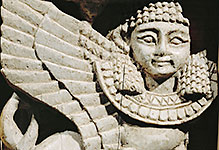
Ancient Middle East
Oriental Antiquities.

#08020912
Praying women, fragment of a stele erected by king Gudea of Lagash, wh...

#08020913
Lyre-player, from one of the steles of king Gudea of Lagash. The lyre has...

#08020914
Annual report concerning the production of timber and reed from the city of Un...

#08020915
Code of law of Ur, cuneiform inscription in Sumerian. 2112-2095 BCE. From Nipp...

#08020916
Seal of Naram-ili, prefect of the potters, period of Shulgi. Such seals we...

#08020917
Mosaics on walls of the temple of the goddess Innin (Ishtar, Astarte) in Uru...

#08020918
Part of a temple wall with gods pouring life-giving water. Burnt clay bricks...

#08020919
The goddess Ishtar and her accolites on a mountain. Ishtar is shown in her w...

#08020920
Drinking vessel in form of a lion's head, from Ugarit (Ras Shamra). Terracotta...

#08020921
Imprint of a cylindrical seal showing a ziggurat and a priest or god....

#08020922
"Sit Shamsi", the ceremony of sunrise. Bronze model of a high place, dedica...

#08020923
Top of a Mesopotamian stele, usurped by the Elamites. A god with orant (damage...